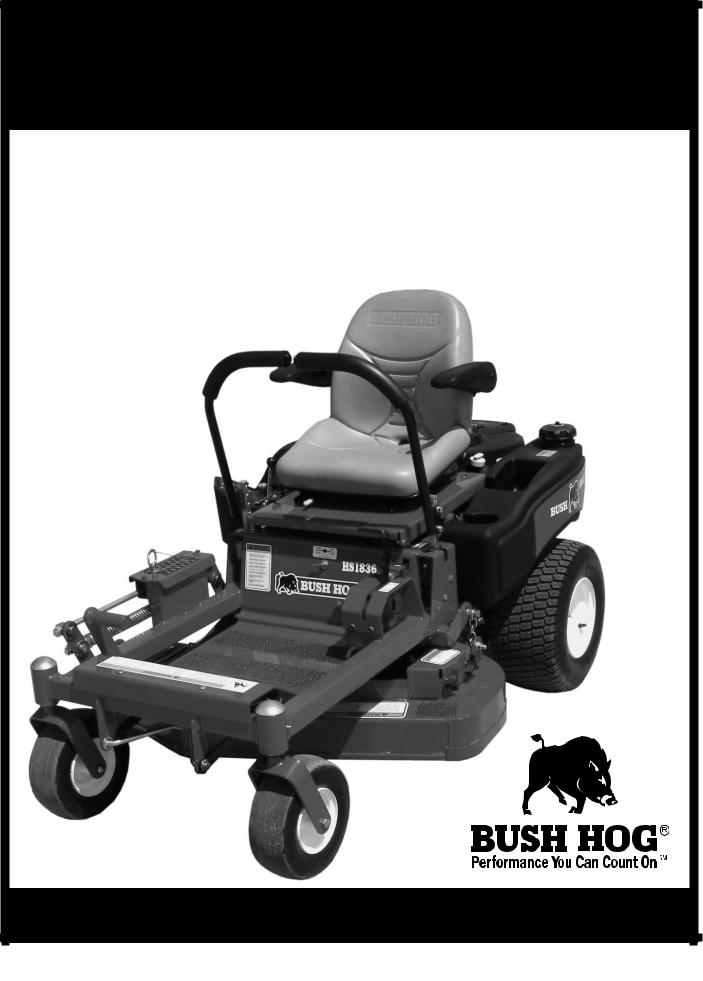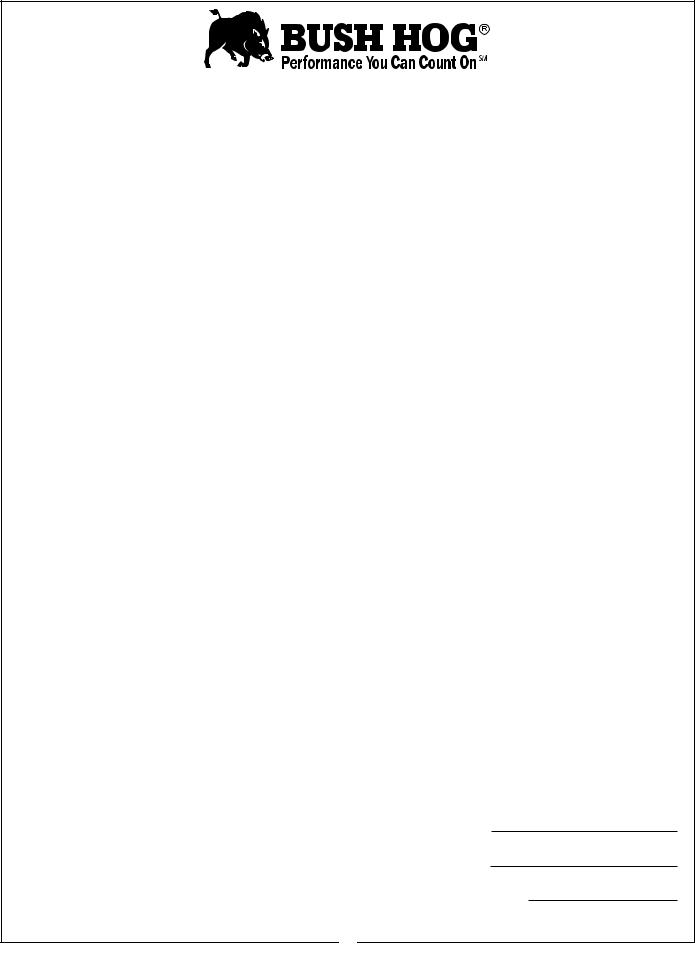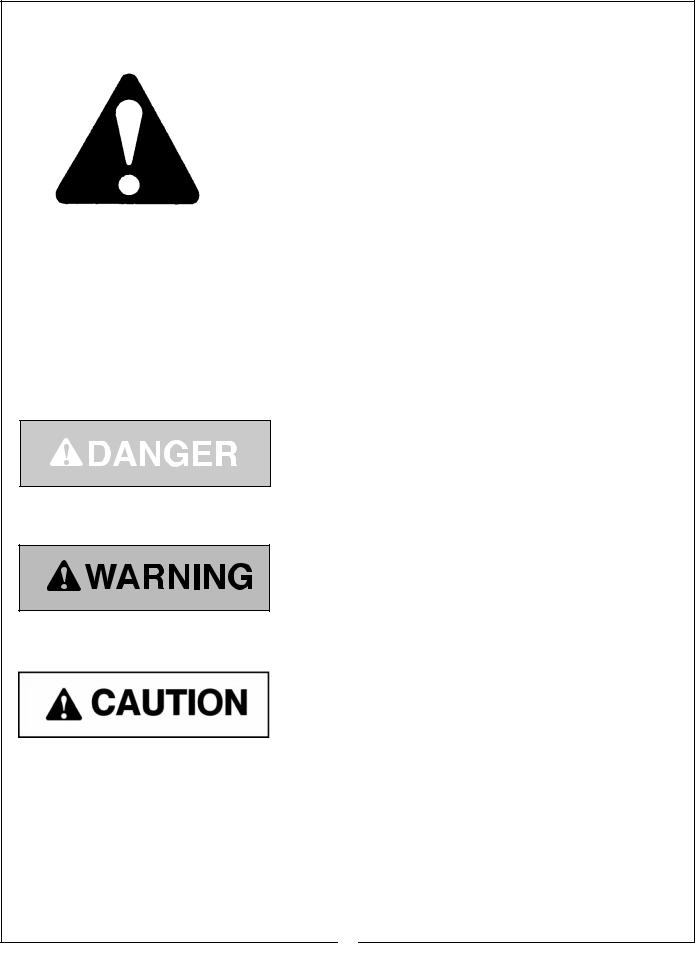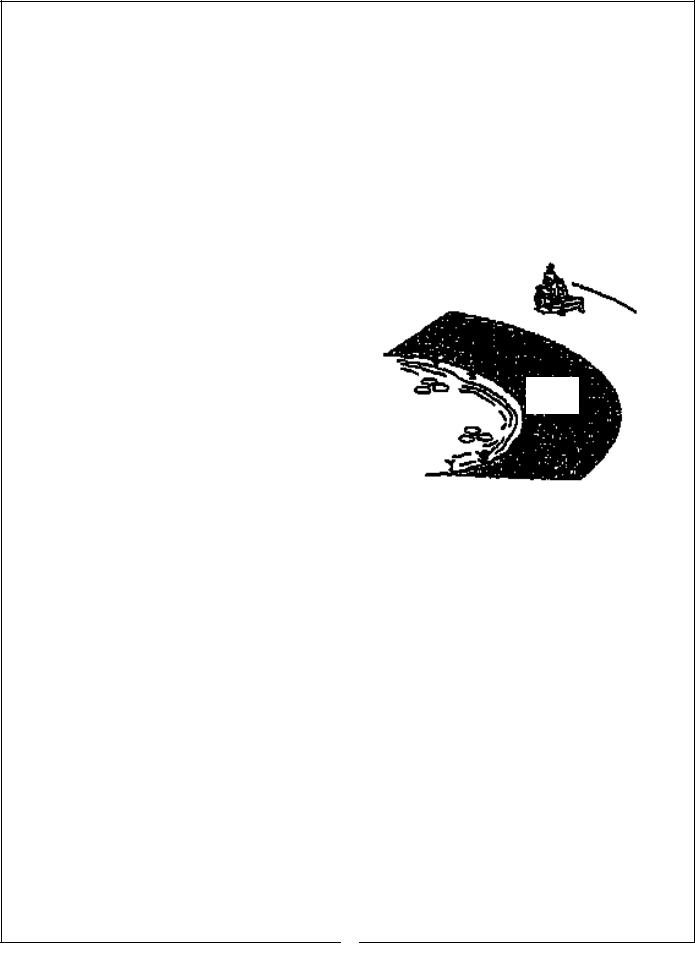Bush Hog Home User Manual

BUSH HOG®
Home Series
Zero Turn Mower
Operator’s Manual
ASSEMBLY • OPERATION • MAINTENANCE
807 |
$4.00 |
50055752 |

CONGRATULATIONS!
You have invested in the best mowerof its type on the market today.
The care you give your Bush Hog mower will greatly determine your satisfaction
with its performance and its service life. We urge a careful study of this manual to provide you with a thorough understanding of your new mower before operating, as well as suggestions for operation and maintenance.
If your manual should become lost or destroyed, Bush Hog will be glad to provide you with a new copy. Order from Bush Hog, P. O. Box 1039, Selma, Alabama 36702-1039. Most of our manuals can also be downloaded from our website at www.bushhog.com.
As an authorized Bush Hog dealer, we stock genuine Bush Hog parts which are manufactured with the same precision and skill as our original equipment. Our trained service personnel are well informed on methods required to service Bush Hog equipment, and are ready and able to help you.
Should you require additional information or assistance, please contact us.
YOUR AUTHORIZED
BUSH HOG DEALER
BECAUSE BUSH HOG MAINTAINS AN ONGOING
PROGRAM OF PRODUCT IMPROVEMENT, WE
RESERVE THE RIGHT TO MAKE IMPROVEMENTS IN
DESIGN OR CHANGES IN SPECIFICATIONS WITH-
OUT INCURRING ANY OBLIGATION TO INSTALL
THEM ON UNITS PREVIOUSLY SOLD.
BECAUSE OF THE POSSIBILITY THAT SOME
PHOTOGRAPHS IN THIS MANUAL WERE TAKEN OF
PROTOTYPE MODELS, PRODUCTION MODELS MAY
VARY IN SOME DETAIL. IN ADDITION, SOME
PHOTOGRAPHS MAY SHOW SHIELDS REMOVED
FOR PURPOSES OF CLARITY. NEVER OPERATE
THIS IMPLEMENT WITHOUT ALL SHIELDS IN PLACE.

HOME SERIES
ZERO TURN RIDING MOWER
TABLE OF CONTENTS
SECTION |
PAGE |
Warranty. . . . . . . . . . . . . . . . . . . . . . . . . . 2
Dealer Preparation Check List . . . . . . . . . 3
Safety Alert Symbols . . . . . . . . . . . . . . . . 4
Safety Precautions . . . . . . . . . . . . . . . . . . 5
Federal Laws and Regulations. . . . . . . . . 8
I INTRODUCTION AND DESCRIPTION . . 9
Introduction. . . . . . . . . . . . . . . . . . . . . . . . 9
Description . . . . . . . . . . . . . . . . . . . . . . . . 9
Specifications . . . . . . . . . . . . . . . . . . . . . 10
II OPERATION . . . . . . . . . . . . . . . . . . . . . 11
General Safety . . . . . . . . . . . . . . . . . . . . 11
Pre-Operation Checklist . . . . . . . . . . . . . 11
Operation . . . . . . . . . . . . . . . . . . . . . . . . 12
Mowing Recommendations . . . . . . . . . . 14
III MAINTENANCE . . . . . . . . . . . . . . . . . . . 15
Maintenance Schedule. . . . . . . . . . . . . . 15
Engine . . . . . . . . . . . . . . . . . . . . . . . . . . 16
SECTION |
PAGE |
Battery . . . . . . . . . . . . . . . . . . . . . . . . . .16
Tires . . . . . . . . . . . . . . . . . . . . . . . . . . . .16
Mower Blades . . . . . . . . . . . . . . . . . . . . .16
Motion Control Adjustment . . . . . . . . . . .17
Drive Adjustments . . . . . . . . . . . . . . . . .17
Test Drive Operations . . . . . . . . . . . . . .17
Leveling The Deck . . . . . . . . . . . . . . . . .18
Counterbalance Spring . . . . . . . . . . . . . .18
Deck Belt Adjustment . . . . . . . . . . . . . .18
Deck Belt Replacement . . . . . . . . . . . . .18
Start Up Maintenance . . . . . . . . . . . . . . .19
Parking Brake Cable Replacement . . . .20
Troubleshooting . . . . . . . . . . . . . . . . . . .21
IV ASSEMBLY . . . . . . . . . . . . . . . . . . . . . .22
Wiring Schematics . . . . . . . . . . . . . . . . .23
Safety Decals . . . . . . . . . . . . . . . . . . . . .25
Torque Specifications . . . . . . . . . . . . . . .27
Optional Equipment List . . . . . . . . . . . . .28
Slope Angle Guide . . . . . . . . . . . . . . . . .29
RETAIL CUSTOMER’S RESPONSIBILITY
UNDER THE BUSH HOG WARRANTY
It is the Retail Customer and/or Operator’s responsibility to read the Operator’s Manual, to operate, lubricate, maintain and store the product in accordance with all instructions and safety procedures. Failure of the operator to read the Operator’s Manual is a misuse of this equipment.
It is the Retail Customer and/or Operator’s responsibility to inspect the product and to have any part(s) repaired or replaced when continued operation would cause damage or excessive wear to other parts or cause a safety hazard.
It is the Retail Customer’s responsibility to deliver the product to the authorized Bush Hog
Dealer, from whom he purchased it, for service or replacement of defective parts which are covered by warranty. Repairs to be submitted for warranty consideration must be made within forty-five (45) days of failure.
It is the Retail Customer’s responsibility for any cost incurred by the Dealer for traveling to or hauling of the product for the purpose of performing a warranty obligation or inspection.
1

HOME SERIES ZERO TURN RIDING MOWER LIMITED WARRANTY
OOOOOOOOOOOOOOOOOOOOOOOOOOOOOOO
Bush Hog warrants to the original purchaser of this new Zero Turn Riding Mower, purchased from an authorized Bush Hog dealer, that the equipment be free from defects in material and workmanship for a period of three (3) years from date of retail sale. The three year limited warranty (third year parts only) includes drive train, electromagnetic clutch, deck and cutter spindles. See dealer for complete details. The obligation of Bush Hog to the purchaser under this warranty is limited to the repair or replacement of defective parts. NOTE: This warranty covers parts and labor for the first two years and parts only during the third year.
Replacement or repair parts installed in the equipment covered by this limited warranty are warranted for ninety (90) days from the date of purchase of such part or to the expiration of the applicable new equipment warranty period, whichever occurs later. Warranted parts shall be provided at no cost to the user at an authorized Bush Hog dealer during regular working hours. Bush Hog reserves the right to inspect any equipment or parts which are claimed to have been defective in material or workmanship.
DISCLAIMER OF IMPLIED WARRANTIES & CONSEQUENTIAL DAMAGES
Bush Hog’s obligation under this limited warranty, to the extent allowed by law, is in lieu of all warranties, implied or expressed, INCLUDING IMPLIED WARRANTIES OF MERCHANTABILITY AND FITNESS FOR A PARTICULAR PURPOSE and any liability for incidental and consequential damages with respect to the sale or use of the items warranted. Such incidental and consequential damages shall include but not be limited to: transportation charges other than normal freight charges; cost of installation other than cost approved by Bush Hog; duty; taxes; charges for normal service or adjustment; loss of crops or any other loss of income; rental of substitute equipment, expenses due to loss, damage, detention or delay in the delivery of equipment or parts resulting from acts beyond the control of Bush Hog.
THIS LIMITED WARRANTY SHALL NOT APPLY:
1.To transportation to and from dealership or service calls made by dealers, ie, driving time, towing, pickup and delivery.
2.To vendor items which carry their own warranties, such as engines, batteries, tires, and tubes.
3.If the unit has been subjected to misapplication, abuse, misuse, negligence, fire or other accident.
4.If parts not made or supplied by Bush Hog have been used in connection with the unit, if, in the sole judgement of Bush Hog such use affects its performance, stability or reliability.
5.If the unit has been altered or repaired outside of an authorized Bush Hog dealership in a manner which, in the sole judgement of Bush Hog, affects its performance, stability or reliability.
6.To normal maintenance service and normal replacement items such as gearbox lubricant, hydraulic fluid, worn blades, or to normal deterioration of such things as belts and exterior finish due to use or exposure.
7.To expendable or wear items such as teeth, chains, sprockets, belts, springs and any other items that in the company’s sole judgement is a wear item.
NO EMPLOYEE OR REPRESENTATIVE OF BUSH HOG IS AUTHORIZED TO CHANGE THIS LIMITED WARRANTY IN ANY WAY OR GRANT ANY OTHER WARRANTY UNLESS SUCH CHANGE IS MADE IN WRITING AND SIGNED BY BUSH HOG’S SERVICE MANAGER, POST OFFICE BOX 1039, SELMA, ALABAMA 36702-1039.
OOOOOOOOOOOOOOOOOOOOOOOOOOOOOOO
Record the model number, serial number and date purchased. This information will be helpful to your dealer if parts or service are required.
MAKE CERTAIN THE WARRANTY REGISTRATION CARD HAS BEEN FILED WITH BUSH HOG/ SELMA, ALABAMA
MODEL NUMBER
SERIAL NUMBER
DATE OF RETAIL SALE
2

DEALER PREPARATION CHECK LIST
HOME SERIES ZERO TURN RIDING MOWER
BEFORE DELIVERING MACHINE — The following check list should be completed.
Use the Operator’s Manual as a guide.
r1. Engine has been serviced.
r2. Battery fluid level is checked.
r3. Low oil pressure light checked for operation.
r4. Operator interlock switches checked for operation.
r5. Assembly completed.
r6. All fittings lubricated.
r7. ZT transaxle filled with oil to appropriate level.
r8. All shields in place and in good condition.
r9. Roll-over Protective Structure (Optional) is installed and retractable seat belt functions properly.
r10. All fasteners torqued to specifications given in Torque Chart.
r11. All decals in place and readable. (See decal page.)
r12. Overall condition good (i.e. paint, welds)
r13. Parking brake checked and adjusted, if necessary.
r14. Steering checked and adjusted, if necessary.
r15. Check tire pressure.
r16. Operators manual has been delivered to owner and he has been instructed
on the safe and proper use of the cutter.
Dealer’s Signature
Purchaser’s Signature
THIS CHECKLIST TO REMAIN IN OWNER’S MANUAL
It is the responsibility of the dealer to complete the procedures listed above before delivery of this implement to the customer.
WARRANTY REGISTRATION AND DELIVERY REPORT
It is the responsibility of the Dealer to do the following:
•Complete the Warranty Registration and Delivery Report
•Return the pre-addressed card copy to Bush Hog, L.L.C.
•Retain pink copy for dealership records
3

Safety Alert Symbol
This Safety Alert Symbol means: “ATTENTION! BECOME ALERT!
YOUR SAFETY IS INVOLVED!”
This symbol is used to call attention to safety precautions that should be followed by the operator to avoid accidents. When you see this symbol, carefully read the message that follows and heed its advice. Failure to comply with safety precautions could result in death or serious bodily injury.
Safety Signs Signal Words
The signal words DANGER, WARNING, AND CAUTION are used on the equipment safety signs. These words are intended to alert the viewer to the existence and the degree of hazard seriousness.
This signal word indicates a potentially hazardous situation which, if not avoided, will result in death or serious injury.
White letters on RED
This signal word indicates a potentially hazardous situation which, if not avoided, could result in death or serious injury
It may also be used to alert against unsafe practices.
Black letters on ORANGE
This signal word indicates a potentially hazardous situation exist which, if not avoided, may result in minor or moderate injury.
It may also be used to alert against unsafe practices.
Black letters on YELLOW
4

IMPORTANT SAFETY PRECAUTIONS
This symbol is used to call attention to safety precautions that should be followed by the operator to avoid accidents. When you see this symbol, carefully read the message that follows and heed its advice. Failure to comply with safety precautions could result in serious bodily injury.
In addition to the design and configuration of equipment, hazard control and accident prevention are dependent upon the awareness, concern, prudence and proper training of personnel in the operation, transport, maintenance and storage of equipment. Lack of attention to safety can result in accident, personal injury, reduction of efficiency and worst of all—loss of life. Watch for safety hazards and correct deficiencies promptly. Use the following safety precautions as a general guide to safe operations when using this machine. Additional safety precautions are used throughout this manual for specific operating and maintenance procedures. Read this manual and review the safety precautions often until you know the limitations.
ACCIDENT PATTERNS TO AVOID
1.CONTACT WITH THE ROTATING BLADE - This accident usually happens when the operator is clearing the discharge chute of grass, (especially when the grass is wet), or when the operator adjusts the machine without turning it off and waiting for the blades to completely stop.
2.PROPELLED OBJECTS - Sticks, rocks, wires, and other objects can be propelled out through the discharge chute or from under the mower housing. Bystanders are particularly vulnerable.
3.GRASS DISCHARGE CHUTE - The mower shall not be operated without the grass discharge chute in its lowered position.
4.OVERTURNING - This happens when riding mowers are used on steep slopes, embankments or hills. The operator in these cases can come in contact with blades or sustain injuries during a fall.
5.MOWER RUNNING OVER THE VICTIM - This usually happens when a riding mower is driven in reverse. The accident victims are most often young children whom, unseen by the operator of the mower, were in the area being mowed.
WE SHARE YOUR DESIRE TO PROTECT YOURSELF, YOUR FAMILY, YOUR FRIENDS AND YOUR NEIGHBORS FROM ACCIDENTAL INJURY. OBSERVING AND ENFORCING THE FOLLOWING GUIDE LINES WILL HELP TO INSURE THE SAFETY OF EVERYONE.
SAFETY INSTRUCTIONS AND RECOMMENDATIONS
1.PEOPLE WHO OPERATE, SERVICE, OR ARE OTHERWISE ASSOCIATED with the Zero Turning Riding Mower should be trained in its proper use and warned of its dangers. Before operating, adjusting, or servicing the Zero Turning Riding Mower they should read and understand this entire manual and the engine manual.
2.AVOID CONTACT WITH MOVING PARTS. Keep hands and feet from under mowing deck and away from blades at all times. Turn engine (motor) off if you must unclog the chute.
3.AVOID HILLS AND SLOPES. Use EXTREME caution when mowing and/or turning on slopes as loss of traction and/or tip-over could occur. Drive slower on slopes. DO NOT mow slopes greater than 15 degrees. Watch for ditches, holes, rocks, dips and rises, which change the operating angle. Keep away from drop-offs and steep banks. Avoid sudden starts when mowing uphill - mower may tip backwards. Loss of traction may occur going downhill - weight transfer to the front wheels may cause drive wheels to slip and cause loss of braking. DO NOT mow slopes when grass is wet - slippery conditions affect steering and reduce traction and braking. The operator is responsible for safe operation on slopes.
4.DISENGAGE POWER TO MOWER BEFORE BACKING UP. Do not mow in reverse unless absolutely necessary and then only after turning around and observing the entire area behind the mower. Go slowly. Most “running over victim” accidents occur in reverse.
5.BEGINNING OPERATORS SHOULD LEARN HOW TO STEER the Zero Turning Riding Mower before attempting to mow. Start with slow engine speed and drive without the blades engaged in open area until comfortable with the machine.
5

SAFETY CONTINUED
6.KNOW HOW TO STOP QUICKLY. Know the location and operation of every control, especially how to brake and how to disengage the mower blades.
7.DO NOT MOVE THE CONTROL LEVERS from forward position to reverse position rapidly. The speed and/or direction of travel is affected instantly by movement of the Control Levers.
8.DO NOT ALLOW CHILDREN TO OPERATE MOWER. Do not allow others who have not had instructions to operate mower. Do not operate the mower when children or others are in the area.
9.ALWAYS TURN ENGINE OFF AND REMOVE KEY before leaving mower to prevent children and inexperienced operators from starting the engine. Never leave the mower unattended with engine running. Always wait for all moving parts and all sounds to stop before leaving operator’s seat. Always set the parking brake on an unattended mower.
10.WEAR STURDY, ROUGH-SOLED WORK SHOES AND CLOSE-FITTING TROUSERS AND SHIRTS. Never operate mower in bare feet, sandals or sneakers.
11.WEAR PERSONAL PROTECTIVE EQUIPMENT such as, but not limitied to, protection for eyes, ears, feet, hands and head when operating or repairing equipment. Do not wear loose clothing or jewelry that may catch on equipment moving parts.
12.NEVER CARRY PASSENGERS.
13.KNOW THE AREA YOU ARE TO MOW. Watch for hidden dangers such as rocks, roots, sticks, holes, bumps, and drop-offs, etc. Before mowing, pick up all debris in area to be mowed. Sharp and hard objects can be propelled at a high speed and can act like shrapnel. Walk through tall grass BEFORE MOWING to make sure there are no hidden dangers. Mow higher than desired in tall grass to expose any hidden objects and/or obstacles, clean the area, and then mow to the desired height.
14.BE SURE THE AREA IS CLEAR of other people before mowing. Stop machine if anyone enters the area.
15.NEVER REFUEL A MOWER INDOORS. Allow the engine time to cool before refueling. Unseen vapors may be
ignited by a spark. Always clean up spilled gasoline. Never run the engine indoors in a garage or any other closed building. Allow engine to cool before storing in any enclosure. The engine exhaust and gasoline fumes are dangerous.
16. NEVER REMOVE THE FUEL CAP or add gasoline to a running or hot engine or an engine that has not been allowed to cool for several minutes after running. Always make sure the gas cap is in place.
17.DO NOT SMOKE AROUND THE MOWER or the gasoline storage container. Gasoline fumes can easily ignite.
18.KEEP GASOLINE IN A WELL-VENTILATED AREA away from your living quarters and in tightly capped safety cans. Never store mower with gasoline in the tank inside a building where fumes may reach open flame or spark.
19.DISENGAGE BLADES, STOP ENGINE, ENGAGE PARKING BRAKE AND REMOVE IGNITION KEY before any servicing. Be sure all moving parts and all sounds have stopped. Let engine cool and disconnect the spark plugs so the engine cannot start by accident.
20.KEEP ALL NUTS, BOLTS, AND SCREWS TIGHT to be sure equipment is in safe working condition, especially blade bolts.
21.VEHICLE SHOULD BE STOPPED AND INSPECTED FOR DAMAGE after striking a foreign object and the damage should be repaired before restarting and operating the equipment. Stop immediately and check for damage or loose parts if mower should start vibrating.
22.DISENGAGE BLADES BEFORE DRIVING ACROSS WALKS or projecting objects or transporting.
23.KEEP SAFETY DEVICES AND GUARDS IN PLACE. If any of the safety switches become inoperable, have them repaired immediately.
24.DO NOT STEP OR STAND ON THE MOWER HOUSING. Step or stand only on the tread areas on the deck.
25.WATCH OUT FOR TRAFFIC near roadways and when crossing roads.
26.THIS MACHINE IS NOT MEANT FOR HIGHWAY OR STREET USE. It is not a recreational vehicle and it should not be operated as such.
27.WHEN FEASIBLE, DO NOT USE MOWER WHEN GRASS IS WET OR SLIPPERY.
28.MOW ONLY IN DAYLIGHT OR GOOD ARTIF ICIAL LIGHT.
6

SAFETY CONTINUED
29.ALWAYS DISENGAGE THE MOWER BLADE CLUTCH when transporting.
30.Do not operate the mower under influence of drugs or alcohol.
31.Do not change the engine governor settings or overspeed the engine. Operating an engine at excessive speed may increase the hazard of personal injury.
TOWING
1.Use for towing only if equipped with a Bush Hog hitch kit. Do not attach towed equipment except at the hitch point.
2.Never allow children or others in or on towed equipment.
3.On slopes, the weight of the towed equipment may cause loss of traction and loss of control.
4.Travel slowly and allow extra distance to stop.
SLOPE OPERATION
 DANGER
DANGER
POTENTIAL HAZARD
Mowing on wet grass or steep slopes can cause sliding and loss of control.
WHAT CAN HAPPEN
Wheels dropping over edges, ditches, steep banks, or water can cause injury, or death by drowning.
HOW TO AVOID THE HAZARD
Do not mow slopes when grass is wet. Water
Do not mow near drop-offs or near water. Do not mow slopes greater than 15 degrees.
Reduce speed and use extreme caution on slopes. Avoid sudden turns or rapid speed changes.
Safe
Zone
Danger
Zone
1.Use EXTREME caution when mowing and/or turning on slopes as loss of traction and/or tip-over could occur. The operator is responsible for safe operation.
2.See inside of the back cover to determine the approximate slope angle of the area to be mowed.
3.Use a walk behind mower and/or a hand trimmer near drop-offs, ditches, steep banks or water. This area can be dangerous.
4.Progressively greater care is needed as the slope increases.
5.Always avoid sudden starting or stopping on a slope. If tires lose traction, disengage the blades and proceed slowly down the slope.
6.Avoid sudden starts when mowing uphill. Mower may tip backwards.
7.Be aware that loss of traction may occur going downhill. Weight transfer to the front wheels may cause drive wheels to slip and cause loss of braking and steering.
8.Watch for ditches, holes, rocks, dips, and rises that change the operating angle, as rough terrain could overturn the machine. Tall grass can hide obstacles.
9.Remove or mark obstacles such as rocks, tree limbs, etc. from the ,mowing area. Tall grass can hide obstacles.
10.Use extreme care with grass catches or attachments. These can change the stability of the machine and cause loss of control.
11.Follow the manufacturer’s recommendations for counterweights to improve stability.
12..Check carefully for overhead clearances (ie. branches, doorways, and electrical wires) before driving under objects and do not contact them.
SLOPE ANGLE GUIDE LOCATED INSIDE REAR COVER
7

IMPORTANT FEDERAL LAWS AND REGULATIONS* CONCERNING
EMPLOYERS, EMPLOYEES AND OPERATIONS.
*(This section is intended to explain in broad terms the concept and effect of the following federal laws and regulations. It is not intended as a legal interpretation of the laws and should not be considered as such).
U.S. Public Law 91-596 (The Williams-Steiger Occupational and Health Act of 1970) OSHA
This Act Seeks:
“...to assure so far as possible every working man and woman in the nation safe and healthful working conditions and to preserve our human resources...”
DUTIES
Sec. 5 (a) Each employer—
(1)shall furnish to each of his employees employment and a place of employment which are free from recognized hazards that are causing or are likely to cause death or serious physical harm to his employees;
(2)shall comply with occupational safety and health standards promulgated under this Act.
(b)Each employee shall comply with occupational safety and health standards and all rules, regulations and orders issued pursuant to this Act which are applicable to his own actions and conduct.
OSHA Regulations
Current OSHA regulations state in part: “At the time of initial assignment and at least annually thereafter, the employer shall instruct every employee in the safe operation and servicing of all equipment with which the employee is, or will be involved.” These will include (but are not limited to) instructions to:
Keep all guards in place when the machine is in operation;
Permit no riders on equipment;
Stop engine, disconnect the power source, and wait for all machine movement to stop before servicing, adjusting, cleaning or unclogging the equipment, except where the machine must be running to be properly serviced or maintained, in which case the employer shall instruct employees as to all steps and procedures which are necessary to safely service or maintain the equipment.
Make sure everyone is clear of machinery before starting the engine, engaging power, or operating the machine.
Child Labor Under 16 Years Old
Some regulations specify that no one under the age of 16 may operate power machinery. It is your responsibility to know what these regulations are in your own area or situation. (Refer to U.S. Dept. of Labor, Employment Standard Administration, Wage & Home Division, Child Labor Bulletin #102.)
8
